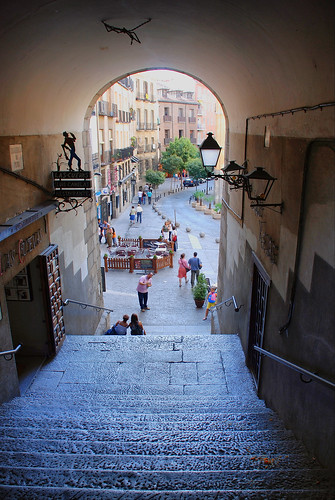La construcción de este arco esta relacionada con la reconstrucción y el cierre de la antigua Plaza Mayor por el arquitecto Juan de Villanueva, después del incendio ocurrido en el verano de 1790. Con esta reforma, la antigua plaza que construyera Juan Gómez de Mora, entre 1617 y 1619, no perdió su configuración rectangular, pero por medio de un sistema de arcadas se consiguió cerrar este recinto urbano y se rebajó la altura del caserío para homogeneizarlo con la que tenía la Casa de la Panadería, que se salvo de las llamas.
Una de estas arcadas, la que daba acceso a la plaza por el extremo sur occidental, es el Arco de Cuchilleros, llamado así porque en el caserío de sus alrededores, a la entrada y a ambos lados de la escalinata que lo precede, estuvieron ubicados los talleres del gremio de cuchilleros y espaderos, pues tenían como una de sus finalidades suministrar sus productos a las carnicerías establecidas en la Plaza Mayor.
La singularidad de este lugar se acrecienta con las trazas de las edificaciones aledañas, construidas la mayoría de ellas en el siglo XVII con el característico zócalo en piedra berroqueña, los lienzos de la fachada con gruesos muros de ladrillos y los huecos de las ventanas engalanados con rejerías y balconadas de hierro forjado.
Sorprende mucho al espectador los seis pisos de altura de algunas de estas edificaciones, pero más sorprendería si todavía se conservaran las ocho plantas con que originalmente se construyeron y que fueron rebajadas tras la reforma de Villanueva. Esta excepcional altura se debe al desnivel que existe entre la plaza y la Cava de San Miguel.
Otro de los aspectos que convierten a este lugar en uno de los cuadros más pintorescos de la ciudad son sus concurridos mesones, herencia de los bodegones, tabernas y hosterías del antiguo Madrid.
Monday, May 19, 2008
Madrid. Arco de Cuchilleros desde la arcada de la Plaza Mayor.
The construction of this arc this related to the reconstruction and the closing of the old Greater Place by the architect Juan de Villanueva, after the fire happened in the summer of 1790. With this reform, the old place that constructed to Juan Go'mez de Mora, between 1617 and 1619, did not lose its rectangular configuration, but by means of a system of arches it was able to close this urban enclosure and the height of the small village stooped to homogenise it with which it had the House of the Bakery, that safe of the flames. One of these arches, the one that gave access to the place by the western South end, is the Arc of Cutlers, call thus because in the small village of its environs, to the entrance and both sides of the perron precedes that it, were located the factories of the union of cutlers and espaderos, because they had like one of his purposes of providing his products to the slaughters established in the Greater Place. The singularity of this place is increased with the plans of the bordering constructions, constructed to the majority of them in century XVII with the characteristic stone socle berroqueña, the linen cloths of the facade with heavy brick walls and the hollows of the windows engalanados with rejerías and forged iron rows of balconies. It surprises much the spectator the six floors of height of some of these constructions, but it would surprise more if still the eight plants were conserved whereupon originally they were constructed and that they were reduced after the reform of Villanueva. This exceptional height must to the unevenness that exists between the place and Cava of San Miguel. Another one of the aspects that turn to this place in one of the most colorful pictures of the city is his concurred inns, inheritance of bodegones, taverns and hosterías of old Madrid.
Subscribe to:
Post Comments (Atom)




0 Comments:
Post a Comment